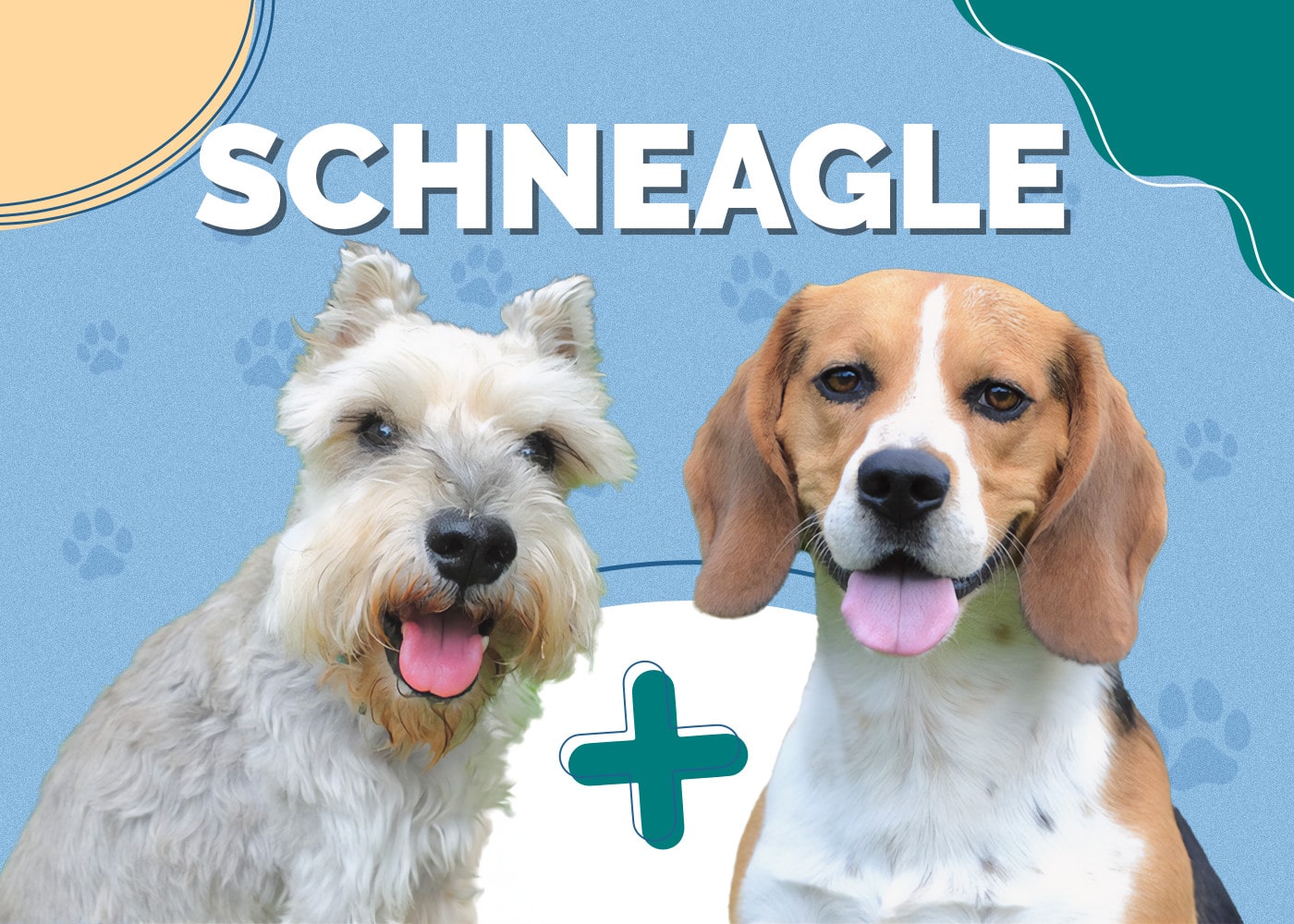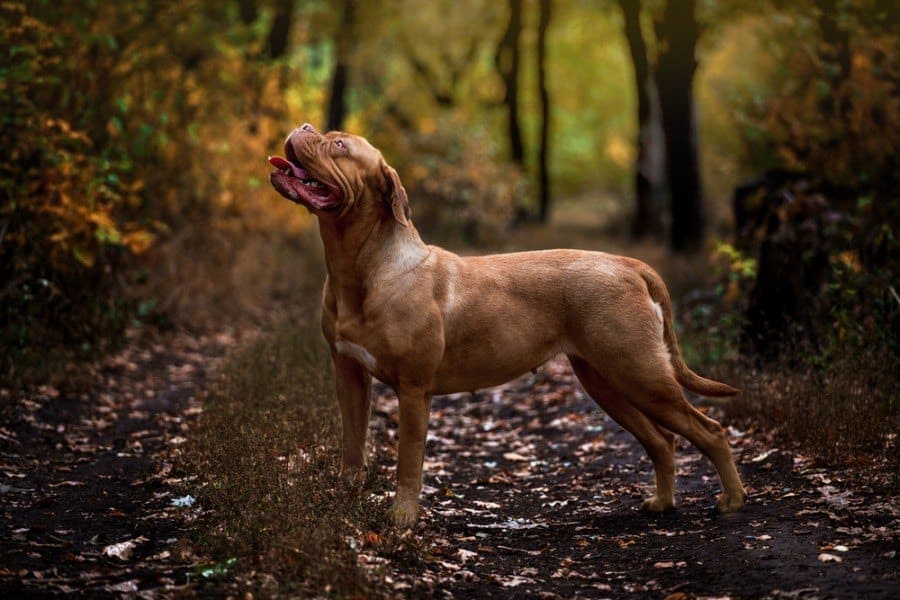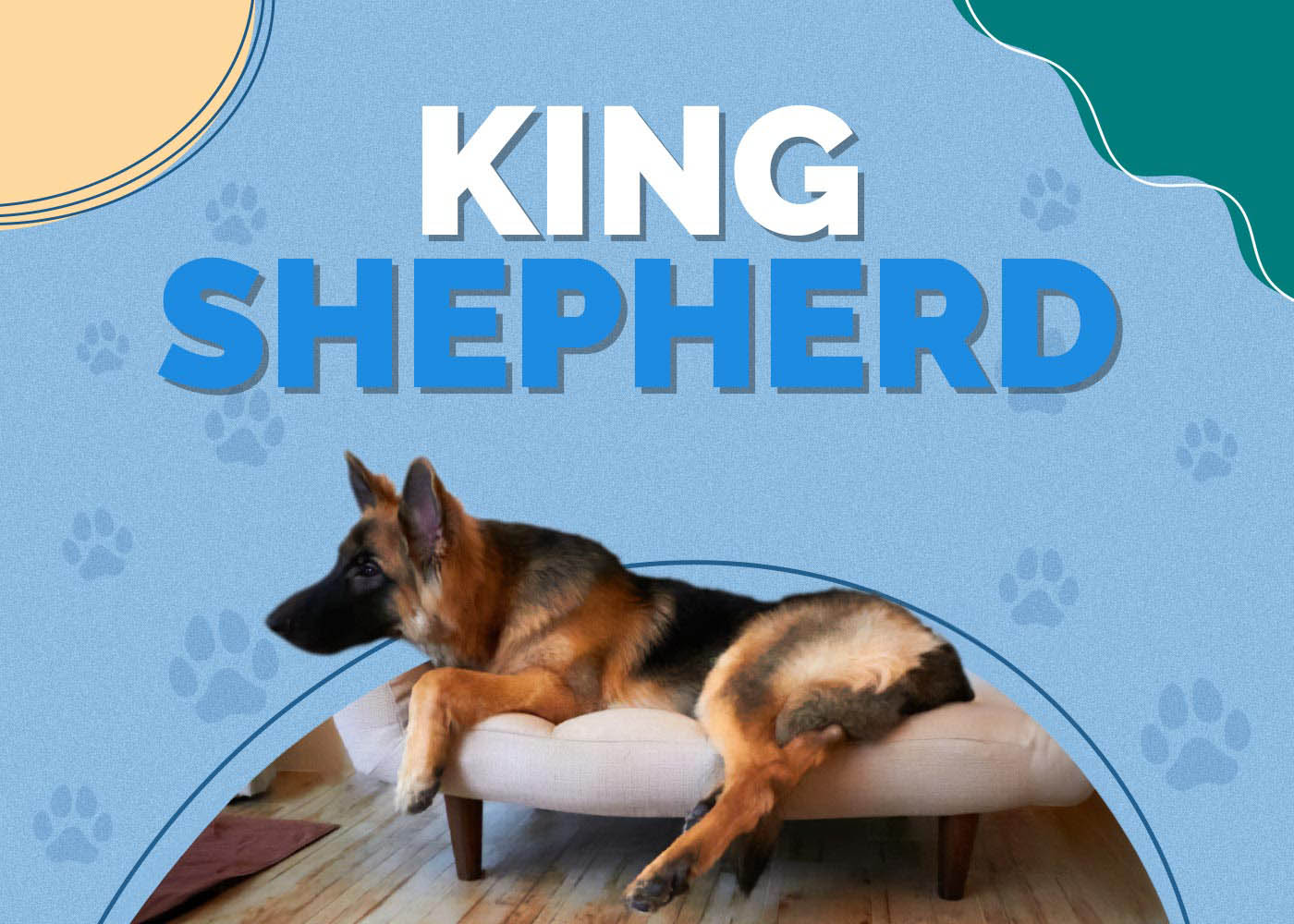Pom-A-Pug (Pomeranian & Pug Mix): Info, Pictures, Facts

Updated on
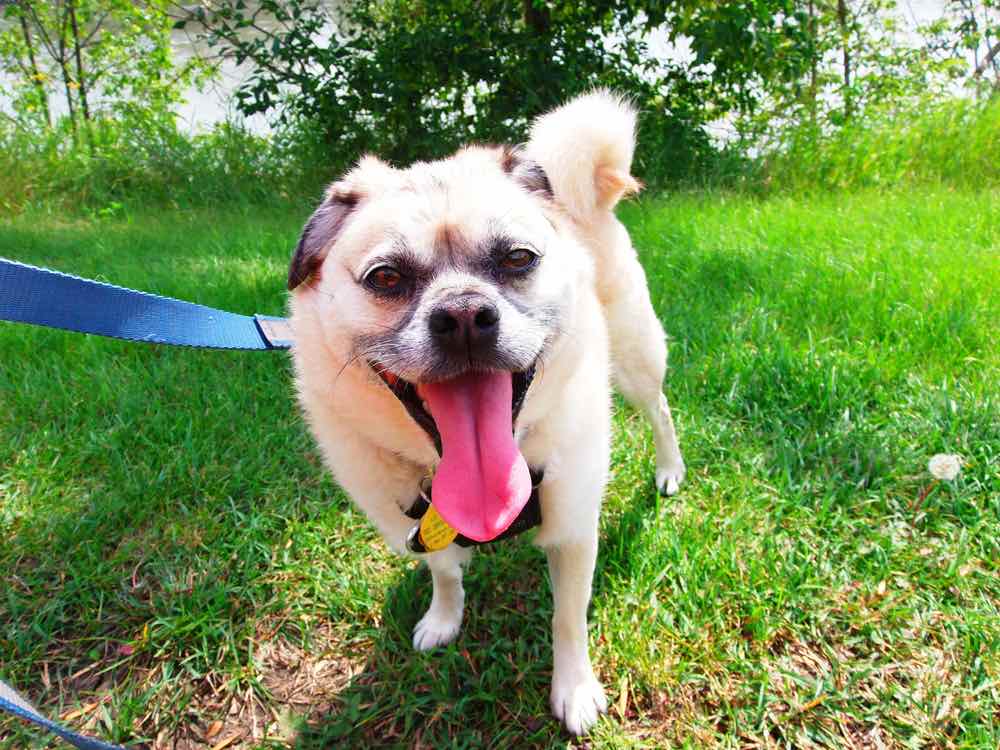
Height:
8-13 inches
Weight:
7-18 pounds
Lifespan:
12-16 years
Colors:
Black, black and tan, beige, fawn
Suitable for:
Families, companions for seniors or singles
Temperament:
Intelligent, affectionate, loyal, cheerful, alert
The Pom-A-Pug is a hybrid mix of a Pomeranian and a Pug and is a funny, friendly companion that is bound to give you regular laughs. These pooches are lap dogs through and through, but they still have a surprising amount of energy reserves and can quickly and suddenly spring into action. They can have physical traits that resemble either of their parent breeds, but they will usually inherit their pug parent’s prominent eyes, short muzzle, and slight underbite. This gives them a somewhat comical yet endearing appearance that is sure to win over every family member. A brief look at each of the parent breeds can help give a deeper understanding of the nature of this pooch.
Pomeranians are small, agile, and energetic balls of fluff with a foxlike face and a massive personality. They have their origins in Germany, deriving their name from the Pomerania province, and were the dog of choice for Queen Victoria. They are feisty little animals that have barks that are far worse than their bite, and in their minds, they are the size of Greyhounds! This fearlessness can sometimes get them into trouble.
Pugs are small and sturdy little pooches, often referred to as the clowns of the canine world. They have a distinctive flat face with large round eyes surrounded by folds of skin that add to their comical nature. They are not lacking in personality and are energetic, playful dogs that love to please their owners. They are also quintessential lap dogs and don’t like to be far away from their human owners.
If we have piqued your interest thus far, read on below to find out more about this loyal lap dog.
Pom-A-Pug Puppies
Beware when going to view a litter of Pom-a-Pug puppies, as you are almost certainly going to bring one home. These gorgeous little pups are irresistible, and even just one may not be enough!
3 Little-Known Facts About the Pom-A-Pug
1. Pomeranians used to be bigger.
It may be hard to believe, but these little pint-sized pooches are originally descended from large, Spitz-type sleigh dogs. Pomeranians weren’t always so pocket-sized, and they used to weigh up to 30 pounds! They were originally bred as sheep-herding dogs and used for sledding, but they became popular among royals in the 18th Century. Queen Victoria is often credited with the creation of the modern Pomeranian, as she is said to have owned a particularly small Pom, and consequently, this made them much sought after. It is well documented that during the Queen’s lifetime, the Pomeranian breed decreased in physical size by as much as 50%.
The Queen is not the only famous Pomeranian owner, as they are known to have been the loyal companions of Michelangelo, Martin Luther King, and Mozart.
2. Pom-A-Pugs are bred for companionship.
Pugs were first bred almost 2,500 years ago, purely as companions. They have been loyal, loving, and devoted companions to humans ever since. They don’t like to be left alone, even for short periods, as it goes against their purpose in life! A Pug is happiest on the lap of their owner.
Although larger Pomeranians were first bred as working dogs, the pocket-sized modern Pom was bred as a loyal companion to the Queen. It is said that Queen Victoria requested her Pomeranian’s presence by her side on her death bed.
The combination of these two dogs is sure to result in the ultimate companion breed.
3. Pugs have ancient roots.
The Pug lineage stretches as far back as 400 BCE, and most believe that they were first bred in ancient China or Tibet, where they were kept as loyal pets by Buddhist monks. Chinese Emperors kept Pugs as lap dogs, and they were consequently treated like royalty, with some sources claiming that they had their own miniature palaces and even personal guards.
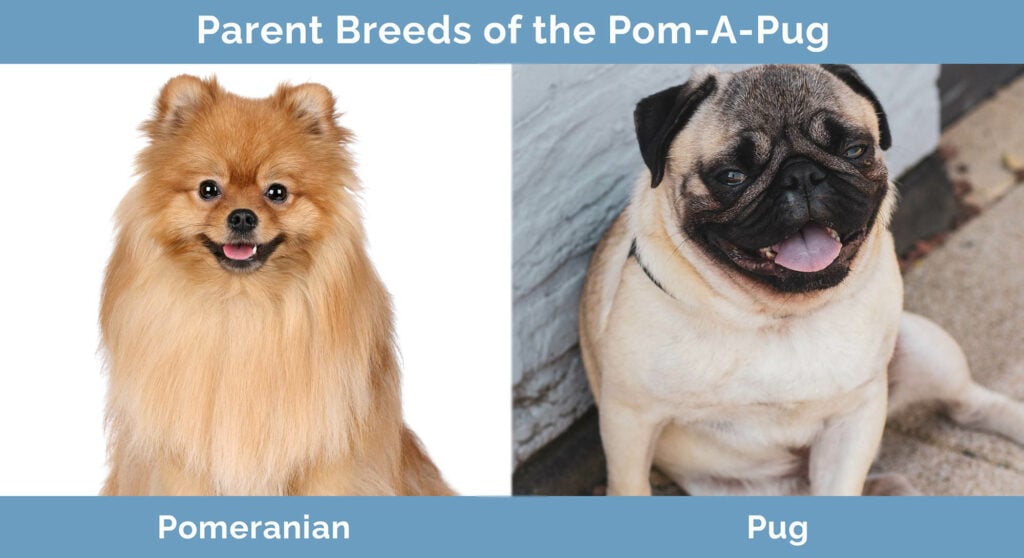
Temperament & Intelligence of the Pom-A-Pug 🧠
The Pom-A-Pug is a cheerful and playful pooch, with a comical edge that will keep you in stitches with their wacky antics. Although they have this clown-like personality at times, don’t be fooled because the Pom-A-Pug is a highly intelligent animal. They can be rather protective of their owners and may take a while to warm up to strangers. Due to their heritage of companionship, they tend to become attached to one person and may act skittish around new faces. These dogs are infamous for being an irresistibly adorable pooch that you just can’t help wanting to pet, but you can’t get near them until you’ve earned their trust.
They have a strong desire to please, and despite their strong companionship instincts, they can exhibit independent natures at times. As long as their owner is within sight, they will enjoy going about their own business in the yard, sniffing out strange scents. But they’ll always have one bulging eye on their owner!
Are These Dogs Good for Families? 🏡
Pom-A-Pugs are great family pets, and kids will love their cartoonish nature and clown-like personality. They love kids and are known to perform endless tricks to get their attention. Their tiny stature and incredible acceleration abilities will keep the family playing for hours, both indoors and in the backyard. Although these dogs love to run around in the open, they are highly adaptable animals that make great pets for apartment living or families with small back yards.
Does This Breed Get Along With Other Pets? 🐶 😽
Pom-A-Pugs will get along famously well with other dogs and pets, though they will assert their place as their owner’s number-one companion. The fierce loyalty and devotion to their role of dedicated companion may cause them to display assertive aggression at times, although these dogs have a bark that is infinitely bigger than their bite, and this usually leads nowhere. That said, they will occasionally pick fights with bigger dogs due to their larger-than-life personalities and will often get more than they bargained for. This is why they need to be well trained from an early age —not because they are inherently aggressive, but because they are extremely loyal and protective.
Things to Know When Owning a Pom-A-Pug
Food & Diet Requirements 🦴
Pom-A-Pugs don’t need much food, but they are known to eat far more than their fair share if given the chance. This is why they should never be freely fed, as they have a high propensity for overeating and obesity. They should be fed no more than 1 to 1½ cups of high-quality dry food per day, with the occasional portion of canned food or lean meat supplemented in.
Unhealthy treats should be strictly avoided due to this breed’s tendency for being overweight, and this includes table scraps at dinner time too. It can be hard to resist those endearing eyes, but it is in their best interests, and a healthy, well-balanced diet is far better for them than momentary gratification.
Of course, fresh, clean water should always be available to your Pom-A-Pug, especially if they are fed mainly on dry kibble.
Exercise 🐕
These dogs are not a high-energy breed and prefer lounging and hanging out with their owners. That said, they will, like all dogs, need a small amount of daily exercise. We recommend a minimum of around 60 minutes a day for Pom-A-Pugs, and breaking exercise up into two shorter chunks is good practice, as it will avoid overexertion. The exercise regime should ideally consist of a long, slow walk or a short, brisk jog, as this breed doesn’t need any high-intensity activity.
These dogs are intelligent, so be sure to incorporate mentally stimulating games into their exercise regime too. They will love interactive games like fetch and frisbee and any kind of activity that involves participation with their beloved owner. Without regular mental and physical stimulation, these dogs can exhibit behavioral issues, and consistent and regular exercise is essential.
Training 🦮
Training a Pom-A-Pug can be a challenge, even with their high intellect and eager-to-please attitude. They are easily distracted and have a notorious streak of rebellion that can override their desire to please their owners. They can get bored easily with repetitive tasks, so training sessions should always be kept short and include as much variety as possible.
Pugs have tiny bladders, so they’ll need to relieve themselves regularly, around every 2 hours. This means Pom-A-Pugs will need to be potty trained early on or trained to use a litter box.
While it can be a challenge, training these little pooches is possible but will take a great deal of patience, consistency, and hard work. The prize of having an obedient little lap dog will make it worth it in the end.
Grooming ✂️
Despite their sometimes fluffy and thick coats, Pom-A-Pugs are fairly low-maintenance pooches. They will only require a brushing around once a week and the occasional bath if they get really dirty. Be sure to check their ears regularly for any signs of infection and that their nails are not too long. Regular teeth brushing will prevent any gum or tooth disease and keep your pooch’s breath nice and fresh.
Health Conditions ❤️
This hybrid breed is usually fairly healthy, without any major breed-specific issues. That said, they can inherit genetic issues from their parent breeds and may suffer from conditions commonly associated with small dogs, like supernumerary teeth and intervertebral disc disease.
Pugs and other dogs with small skulls can suffer from brachycephalic airway obstruction syndrome (BAOS), a condition caused by excess soft tissue that can obstruct their airways.
They also can suffer from eye issues like cataracts, keratoconjunctivitis sicca (dry eye), and general eye injury due to their flat face and bulging eyes. Their flat face can also cause some issues when eating. They tend to swallow air while eating and can thus suffer from bloat.
The wrinkled folds found in Pugs and sometimes in Pom-A-Pugs can be a breeding ground for infection and should be regularly checked and kept clean and dry.
The small legs and bodies of these dogs can lead to musculoskeletal issues like hip dysplasia and patella luxation, so you should avoid letting these dogs jump from high places and most importantly, keep them from getting overweight.
- Bloat
- Cataracts
- Skin infections
- Keratoconjunctivitis sicca
- Cancer
- Brachycephalic airway obstruction syndrome
- Hip dysplasia
- Patella luxation
- Progressive retinal atrophy
Male vs. Female
The Pom-A-Pug is an ideal choice of a canine companion, and the last decision to make is whether to get a male or female. All dogs, whether male or female, will have their own unique character and personality. Therefore, their upbringing and environment have a far larger part to play. A neutered male and spayed female will render most differences inconsequential, which will also lead to a happier dog all-round.
In general, males tend to be more affectionate than females, and they have a more laidback and relaxed attitude and demeanor. But they are usually more of a challenge to train, with a higher propensity for disobedience, and they are easily distracted and slightly more stubborn. Females can get more attached to their owners and are often more protective than males. They are also prone to mood swings and will only show affection when it suits them, as opposed to the male’s never-ending attention-seeking.
Final Thoughts
These clownish and funny little pooches are sure to make you laugh daily, and they are experts at bringing a smile to their owner’s face. The Pug Pomeranian mix were bred for companionship and take this job seriously, without ever lapsing in their loyalty or love. They become attached to their owners, though, and so bear in mind that these are dogs that need to be around you most, if not all, the time and are not ideal pets if you are away frequently.
They are the quintessential lap dog and will love nothing more than doing just that. If you are looking for a dog purely for companionship, there is arguably no better dog in the world more suited for the purpose.
See also:
- Silky Pug (Pug & Silky Terrier Mix): Info, Pictures, Characteristics & Facts
- Schnug (Miniature Schnauzer & Pug Mix) Info, Pictures, Facts, Traits
Featured Photo Credit: Melissa Staroszik, Shutterstock




